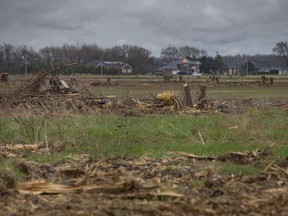
Article content
A $5-billion battery plant expected to create thousands of jobs may be enough incentive for Windsor city council to take on new tax-supported debt for the first time in years.
advertisement 2
Article content
To secure the largest private sector investment in Ontario history — a joint venture between LG Energy Solution and Stellantis to power electric vehicles — the city agreed to assemble land for a 4.5-million-square-foot giga factory. While city reserves hold more than enough funds to pay $45 million for nearly 182 acres necessary short term, Windsor is looking to debt finance the industrial land acquisition through borrowing.
A two-decade-long path to “debt reduction” has placed the city in a good and “enviable position,” Joe Mancina, city treasurer and chief financial officer, told the Star. As a result of council’s “debt-averse” commitment Over years to a pay-as-you-go spending plan, he said leveraging debt is a reasonable option for “specific types of investment,” especially to spur such a major economic development.
advertisement 3
Article content
“This is a significant economic investment in the city — a once-in-a-generation type investment,” Mancina said.
A report from city administration recommends that council on Monday authorize land acquisition costs to be financed through the issuance of debentures to Ontario Infrastructure, which offers terms of up to 30 years, with fixed principal and interest payments made annually.
“Infrastructure Ontario, they work specifically with public sector organizations,” Mancina said. “They provide very competitive financing rates,” and municipalities, universities, hospitals, and other organizations look to Infrastructure Ontario “as a primary source of debt financing.”
Windsor Mayor Drew Dilkens said issuing debt to buy land for the battery plant, which is expected to result in 2,500-plus jobs, “is a very sensible approach” compared to the city’s other options: “raiding” the capital budget, which would delay or defer capital projects, or “draining” capital reserves.
advertisement 4
Article content
“This does not mean that all of a sudden the city or city council, or myself, has suddenly done a 180 in philosophy, where all of a sudden we’re prepared to issue all kinds of debt and the sky’s the limit,” Dilkens said. “This is a very strategic issue of debt for a very particular purpose, the benefit of which will last decades and decades for the community,” he said, referring to the project’s large job creation potential.
The plant will be located on 220 acres at the corner of EC Row Avenue and Banwell Road and extend to the Canadian Pacific Railway tracks. The city already owned about 42 acres and conditionally acquired the remaining 182 ahead of Stellantis and LGES publicly announcing the plant in March. Council voted to expropriate the final necessary acre—one residential lot—during its last meeting.
advertisement 5
Article content
Although the city will offer tax breaks for the plant under its Community Improvement Plans that will see the land taxed at current agricultural rates for the first 20 years, Dilkens said the company will pay its “fair share of property taxes” in the following years, “which we will then use to drive down the debt that we are incurring.”
In 2003, the city’s long-term debt level peaked at $230 million and represented about 68 per cent of its total financial assets. Flash forward to 2021, that rate has dropped significantly to 5.3 per cent, with current tax-supported debt effectively eliminated.
Given council’s recent approval of long-term mortgage debt financing for the Community Housing Corp. to fund repairs and renewal of existing public and non-profit housing complexes, the city’s long-term debt will rise to an estimated $120 million if council approves debt financing to buy the battery plant land.
advertisement 6
Article content
Debt-financing the land purchase “is not trying to bump us off the course that we’ve been on,” Dilkens said. “We still plan on being very cautious.
“This will just be another pressure added to the budget deliberations that council, like every year, has to figure out how to address.”
-
City to expropriate land for battery plant
-
$5B Windsor battery plant the largest private sector investment in Ontario history
-
Scale of impact of Windsor battery plant hard to fathom
While debt projections are increasing, “they are still well below the peak levels reached in the early 2000s and should be considered in the context of a much-improved balance sheet,” the staff report said.
Existing cash reserves can be used to finance the land acquisition for several months until an Infrastructure Ontario debenture comes through. As of December 2020, city reserves totaled about $260 million, and have “continued to increase throughout 2021,” the report said.
advertisement 7
Article content
“The city has made great progress building up reserves,” Mancina said. “Those reserves are vital to keep because they provide adequate cashflows. A number of those reserves are restricted funds where you can’t use them for other purposes.”
An additional $8 million required for site servicing, like moving an open drain that crosses the middle of the property, will be incorporated as part of the 2023 capital plan, subject to council approval, and may be covered in part by grants.
Construction on the electric vehicle battery plant is expected to begin this summer and reach full capacity in 2025.


